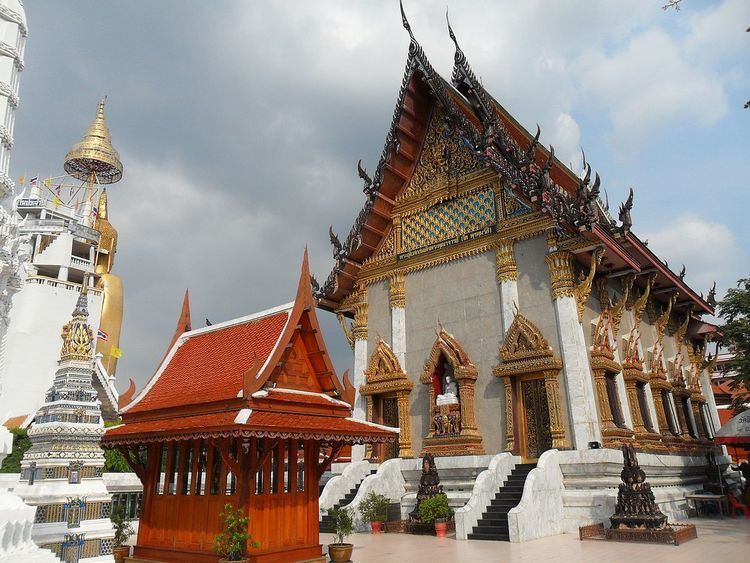Phone +66 2 628 9989 | ||
 | ||
Address Samsen Rd, Khwaeng Bang Khun Phrom, Khet Phra Nakhon, Krung Thep Maha Nakhon 10200, Thailand Similar Wat Ratchanatdaram, Wat Saket, Wat Ratchabophit, Wat Mahathat Yuwaratrangsarit, Wat Benchamabophit | ||
Wat intharawihan
Wat Intharawihan or Wat Intharavihan (Thai: วัดอินทรวิหาร, [wát ʔintʰaráʔwíʔhǎːn]) is a wat (temple) located in the Nakhon District of Bangkok, Thailand.
Contents
- Wat intharawihan
- Wat intharawihan standing buddha bangkok thailand dji mavic pro
- Location
- History
- Buddha statue
- Temple
- Guanyin shrine
- Worship
- References
Wat intharawihan standing buddha bangkok thailand dji mavic pro
Location
The Wat is at the northern edge of the Banglamphu area of the Phra Nakhon district in Bangkok. Access to the temple is by boat along the Chao Praya River close to Thanin Wisut Kasat. Road access is through local transport. The north bound Samsen road leads to this Wat which is hidden below the elevated expressway. Also called Wat In, of the late Ayuthhya period, when it was called Wat Bang Khunphrom Nok in the name of the suburb where it is located.
History
The Wat is a royal temple categorized as Class III, which was built at the beginning of the Ayutthaya period, and was originally called Wat Rai Phrik (meaning in Thai language:"Vegetable"). It was so named as its location was within a vegetable garden. The land where the temple is situated was provided by King Rama I to accommodate the prisoners of war. The King Rama VI Vajiravudh got it refurbished by Chao Inthawong, where after it has been known as Wat Intharavihan. Chao Inthwong also brought a priest from Vientianne to preside as the abbot of the temple. The temple then was given a new name as Chai Inthawong.
Buddha statue
The Wat's main architectural depiction is a 32 metres (105 ft) high, 10 metres (33 ft) wide standing Buddha statue referred to as Luang Pho To or "Phra Si Ariyamettrai" (Maitreya). Building the Buddha statue was started in 1867 and it took sixty more years to complete it in 1927. The image is made of brick and stucco. Ajon Toh, the then Abbott of the temple was the inspiration to build it. He died at the foot of the image in 1871 when it was being built. A gilded bust of this Abbott is enshrined at the temple entrance. The Buddha image is carrying bowl and stairways at the sides to the back behind the statue provides access for devotees to paste gold leaf on the statue. The image is called Luang Phor To. In 1982 during 200th anniversary of the establishment of Bangkok city the image was refurbished and fitted with Italian golden mosaic tile. The statue which is decorated in glass mosaics tiles is gilded with 24-carat gold. The topknot, called Ushnisha, of the Buddha statue contains a relic of Lord Buddha which was given as a gift by the Government of Sri Lanka. The enshrinement of the Buddha relic in the Ushnisha was done by Prince Vajiralongkorn, the knot was placed in 1978. In 1982, during 200th anniversary of the establishment of Bangkok city, the image was refurbished and fitted with Italian golden mosaic tiles.
Temple
The temple has an ordination hall called the Ubosot (prayer hall) also known linguistically as Bod. Its architecture reflects the style followed during the Ayutthaya period. It was refurbished in 1982. Italian marble is used to decorate the lower part of the hall and the walls are decorated with traditional paintings. The sema boundary posts marking the limits of the Ubosot are mounted over small naga images. The murals on the walls have the theme of the daily life in Siam. There is also a practice at this venue to make and sell amulets.
An image of Phra Puttahachan, who was an abbot in the temple is enshrined in a separate newly constructed chamber in the temple. The image is made of wax and is placed over a spring of water. Water collected from various regions of Thailand is preserved in containers placed in the shelves in the chamber. Air conditioning is provided to preserve the wax image. The same is dimly lighted and devotees do meditation here as it has a special ambiance.
Guanyin shrine
There is another shrine here dedicated to Guanyin, a bodhisattva, the female deity of mercy in Mahayana Buddhism. In the East Asian Buddhism tradition, she is folk goddess who is worshipped as Bodhisattva of Compassion. There is also a Chinese version of Avalokitesvara.
Worship
Devotees who visit the temple for worship offer mackerel, a boiled egg and a garland of flowers which they place with reverence at the foot of the Buddha image.
